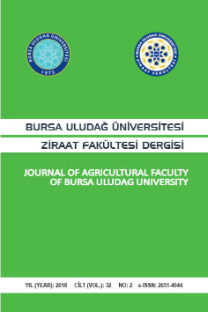Piliç etlerinde lipid oksidasyonu sonucu oluşan malonaldehit (MA) konsantrasyonları
Lipid oksidasyonu, çiğ veya pişmiş et ürünlerinin buzdolabı ısısında ve dondurulmuş şartlardaki bozulma derecesini, dolayısıyla etlerin kalitesini gösteren en önemli parametrelerden biridir ve tiyobarbitürik asit ölçümüyle (TBA) belirlenmektedir. Lipid oksidasyonu, yüksek oranda doymamış yağ asidi bulunan ve ısı uygulanan piliçlerde kolayca oluşabilmektedir. Bu çalışmada, Bursa ve civarında bulunan askeri birliklerin tavuk eti ihtiyacını karşılamak üzere satın alınan piliç etlerindeki TBA düzeylerinin [ug malonaldehit (MA)/g numune olarak) belirlenmesi ve tüketici sağlığı açısından oluşturabileceği risklerin irdelenmesi amaçlanmıştır. MA konsantrasyonları, 2001-2004 yılları arasında, toplam 55 piliç numunesinde spektrofotometrik bir yöntemle belirlendi; minimal 0.007, maksimal 0.850 ve ortalama 0.248 $\mu$ gMA/g olarak tespit edildi. Araştırmanın sonuçlarına göre, analizi yapılan piliç etlerindeki MA düzeylerinin insan sağlığı açısından bir risk oluşturamayacağı kanısına varıldı.
Anahtar Kelimeler:
kümes hayvanları, malonaldehit, tavuk, lipit peroksidasyonu, gıda depolama, tavuk eti
Malonaldehyde (MA) concentrations due to lipid oxidation in chicken meat
Lipid oxidation is one of the most important parameters that shown deterioration degree and quality of raw and cooked meat products during refrigerated or frozen storage, and determine by analysis of thiobarbituric acid. Lipid oxidation occurs easily in chicken, whose fat is higly unsaturated and heat treatment. The aim of this study was the determination of the TBA values [as ug malonaldehyde (MA)/g sample] in chicken meats that purchased to soldiers in Bursa and to discuss the probable risks of determined MA levels for consumer using these chicken meats. MA levels of the 55 samples, that were brought between 2001 and 2004, were determined by the spectrophotometric method. The MA levels determined were minimum 0.007, maximum 0.850 and mean 0.248 $\mu$ gMA/g. It was concluded from the results that MA levels found in the chicken meat samples are not any risk for consumer health.
Keywords:
poultry, malonaldehyde, fowls, lipid peroxidation, food storage, chicken meat,
___
1. BELTRAN E, PLA R, YUSTE J, MOR-MUR M. lipid oxidation of pressurized and cooked chicken: role of sodium chloride and mechanical processing on TBARS and hexanal values. Meat Sci. 2003; 64:19-25.2. ESTERBAUER H, SCHAUR RJ, ZOLLNER H. Chemistry and biochemistry of 4-hydroxynonenal, malonaldehyde and related aldehydes. Free Rad. Biol. Med.l991;l 1:81-128.
3. FRANKEL EN. Volatile lipid oxidation products. Prog. Lipid Res. 1982; 22:1-33.
4. FRANKEL EN. Chemistry of free radical and sinlet oxidation of lipids. Prog. Lipid Res. 1985; 23:197-221.
5. GOMES HA, SILVA EN, NASCIMENTO MRL, FUKUMA HT. Evaluation of the 2-thiobarbituric acid method for the measurment of lipid oxidation in mechanically deboned gamma irradiated chiken meat. Analytical, Nutrition and Clinical Methods Section 2003; 80:433-437.
6. HALLIWELL B, GUTTERIDGE JMC. Free Radicals in Biology and Medicine. HALLIWEL B. GUTTERIDGE JMC, Eds. Oxford University Pres: New York, 1989; 35(l-2):7-20.
7. JO C, AHN DU. Fluorometric analysis of 2-thiobarbituric acid reactive substances in turkey. Poult. Sci. 1988; 77(3):475-480.
8. KHANNA N, SHARMA DP, AHLAWAT SS, SAHOO J. Studies on shelf-stable bone-in-meat pickle form spent hen. J. Food Sci. Technology-Mysore 2004; 41(4):445-447.
9. KUBOW S. Lipid oxidation products in food and artherogenesis. Nutr. Rev., 1993; 51(2):33-40.
10. MARASCHIELLO C, SARRAGA C, REGUEIRO JAG. Glutathione peroxidase activity, TBARS, and a-tocopherol in meat from chckens fed different diets. J. Agric. Food Chem.1999; 47:867-872.
11. MODI VK, MAHENDRAKAR NS, SACHINDRA NM, RAO DN. Quality of nuggets prepared from fresh and smoked spent layer chicken meat. Muscle Foods 2004; 15(3): 195-204.
12. MORIN RJ, HU P, PENG SK, SEVANIAN A. Cholesterol oxides and carcinogenesis. J. Clin. Lab. Anal. 1991;5:219-225.
13. 0LGUNOĞLU I A, POLAT A, VAR I. Chemical and sensory changes of pike perch (Sander Lucioperca Bogustkaya & Naseka 1996) fillets during frozen storage (18 degrees C). Turk. J. Vet. Anim. Sci. 2002; 26(4):879-884.
14. PANIANGVAIT P, KING AJ, JONES AD, GERMAN BG. Cholesterol oxides in foods of animal origin. J. Food Sci. 1995; 60(6): 1159 1174.
15. PEARSON AM, GRAY JI, WOLZAK AM, HORENSTAIN NA. Safety imlications of oxidized lipids in muscle foods. Food Technol. 1983; 37(7):121-129.
16. PENG SK, HU B, MORIN RJ. Angiotoxicity and athero-genecity of cholesterol oxides. J. Clin. Lab. Anal. 1991;5:144-152.
17. PORTER NA, CALDWELL SE, MILLS KA. Mechanims of free radical oxidation of unsturated lipids. Lipids 1995; 30(4):277-290.
18. RHEE KS, ANDERSON LM, SAMS AR. Lipid oxidation potential of beef, chicken, and pork. J. Food Sci. 1996; 61(1):8-12.
19. SMITH LL. Cholesterol autoxidation 1981-1986. Chem. Phys. Lip. 1987;44:87-125.
20. TÜRK STANDARDI 11566: Et ve Et Ürünleri-Kıyma, TS 11566, Kimyevi Özellikler, Muayeneler, sayfa 3-7, Mart 1995.
21. TÜRK STANDARDI 12328: Tavuk Parça Etleri-Kemiksiz Etler-Kıyma, TS 12328, Kimyasal Özellikler, sayfa 2, Kasım 1997.
22. TÜRK STANDARDI 2409: Tavuk Gövde Eti (Karkas), TS 2409, Kimyasal Özellikler, sayfa 4, Kasım 1997.
- ISSN: 1301-3173
- Yayın Aralığı: Yılda 2 Sayı
- Başlangıç: 1981
- Yayıncı: Ahmet Akkoç
Sayıdaki Diğer Makaleler
Engin KENNERMAN, Cahit BABÜR, Selçuk KILIÇ
Mikotoksinler ve tanı yöntemleri
Assessment of microbiological contamination factors in frozen stuffed snail processing stages
Canan DOKUZLU, UĞUR GÜNŞEN, SERAN TEMELLİ, M. K. Cem ŞEN
Biyolojik silah olarak hemorajik fever virusları: Teşhis, tedavi ve kontrol
M. Kazım BÖRKÜ, Yunusemre ÖZKANLAR, BAŞAK HANEDAN, Kerem URAL
Alterations in some blood parameters after high level ethanol intake
SERAN TEMELLİ, M. K. Cem ŞEN, Şahsene ANAR
Piliç etlerinde lipid oksidasyonu sonucu oluşan malonaldehit (MA) konsantrasyonları
